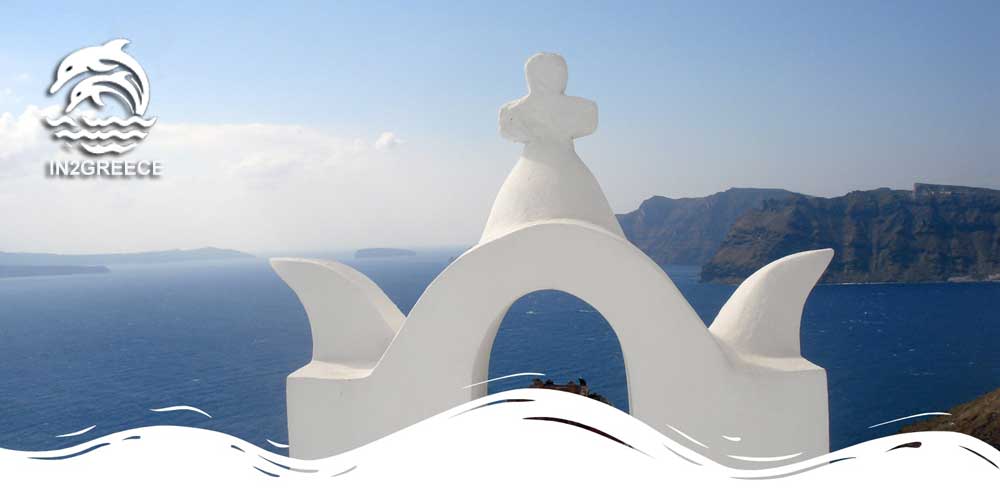The island of Karpathos Greece
Karpathos is an island in the Dodecanese, located between Rhodes and Crete. Its history dates back to the Neolithic period, with mythology suggesting that the Titans were its first inhabitants. Trade with Crete greatly contributed to the island’s development.
Many relics from antiquity, as well as from the periods of Venetian and Ottoman rule, can be found in Karpathos and are open to visitors. On the uninhabited island of Saria, to the north of Karpathos, there are finds ranging from the Neolithic era to structures from the 10th century. Museums in Karpathos enrich the knowledge of interested visitors.
Karpathos boasts a coastline with some of the most beautiful beaches in the Aegean. Whether sandy or pebbly, the crystal-clear waters with their turquoise hues and the rich underwater world offer a perfect setting.
Many beaches are organized with sunbeds, umbrellas, and water sports facilities, with some stretching out into the open sea, ideal for windsurfing, while others are sheltered in deep coves. Some beaches reflect the greenery of trees reaching the shore, giving the waters an emerald hue, and some have been awarded for their quality over the years.
The villages of Karpathos are built in traditional architecture, which is not only preserved but also maintained by the locals. The houses themselves are worth observing, with their balconies and sea views, tiled roofs, and layout. Olympos, literally hanging from the mountain’s peak and descending the slopes, will amaze visitors with the traditional costumes worn by the women even today.
The terrain of Karpathos consists of green mountainous masses with steep gorges ending in sea capes, numerous streams contributing to the island’s rich fauna, caves with stunning decorations accessible to visitors, and settlements built on slopes or coastal areas.
This narrow island, which dominates between Rhodes and Crete, is characterized by its unadulterated tourist landscapes, picturesque settlements, the hospitality of its inhabitants and its inseparable relationship with customs and traditions.
Without a lack of tourist infrastructure, it is an ideal destination for those who are satisfied with quiet holidays without lifestyle elements, with sandy beaches and emerald waters, with open-hearted people who give their all at the local festivals.
Contents- History
- Geography
- Culture
- Cuisine
- What to See
- What to Do
- Villages
- Beaches
- Weather
- When to go
- Getting around
- Getting there
Why choose Karpathos for your holiday
Only a few years ago, thanks to the modernization of its small airport, tourism in Karpathos has become an important economic resource. Since, then, the airport began to serve European low cost airlines, foreign visitors have increased exponent.
Karpathos with its variety, contrast and harmony of lines, volumes and colours compose an incomparable charm, highlighting it as one of the most beautiful islands of the Dodecanese and of Greece. The variety and colour magic of the natural landscape of Karpathos is unique.
The changes and contrasts are so frequent and unexpected, that they leave no room for monotony and boredom. Mountain slopes with steep ravines and labyrinthine streams, deep caves endowed with the alluring multicolour stalactites, green valleys and springs with crystal waters that purr melodiously, generously spreading their coolness.
Alternative tourism follows marked trails ranging from easy to difficult, passing through forests and leading to villages with countless attractions or to beaches of stunning beauty. Cycling is also popular in Karpathos for enthusiasts.
The underwater world attracts many diving and amateur snorkelling enthusiasts. Over 100 climbing routes await climbers. Birdwatchers and botanists will find the island unparalleled, as its biodiversity is vast and protected. Over 80 species of rare plants are found on the island, along with wild raptors and the Mediterranean monk seal (Monachus monachus).
Without a lack of tourist infrastructure, Karpathos it is an ideal destination for those who are satisfied with quiet holidays without lifestyle elements, with sandy beaches and emerald waters, with open-hearted people who give their all at the local festivals.
History
Karpathos is one of those places to have preserved the same name in its history, ever since the time of Homer, hence the certainty that this place has always made a difference, a fact all the better corroborated by a mere reference to the Minoan and Mycenaean tombs as well as to the unearthed remains of settlements dating from the 2d Millennium BC, much frequented by antiquity-avid tourists.
Subsequent to its conquest by the Dorians (circa 1000 BC), the island was given the alternative name of Tetrapolis, a name suggesting the existence of four (tetara in Dorian Greek) cities on it.
Interestingly, the names of certain of those settlements have survived to this day: Arkesia (near the site of the actual township of Arkassa), Vrykous (currently Vrikounta), Nissyros (the Saria island), Possideion a.k.a. Potidaeon (currently referred to as Pigadia). Later on, during Classical and further into the Hellenistic period, Karpathos would inevitably follow the fate of Greece as a whole. In the year 42 BC it came under Roman rule, a condition that remained unchanged until Byzantium became the new ruler.
Pirate raids terrified dwellers of the coastal settlements, who chose to resettle in highest areas. An example of such resettlement is the Byzantine township of Olympos still on foot and very much alive today.
The Byzantine rule is followed by several centuries of successive slavery: first came the Genovese, succeeded by the Knights of the Order of St. John, the Venetians and last the Ottomans.
The Greek war of Independence from the Ottoman Rule in brought temporary freedom, before the island was once again handed over to the Ottoman Empire by virtue of a Treaty (1830). In 1912, the island came under Italian rule, a condition preserved until after World War II, when the island officially became part of the Greek territory.
Geography
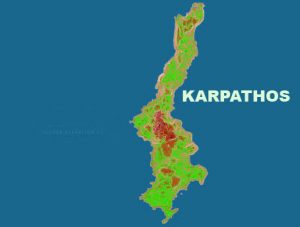
The highest point on the island is Mt. Lastos, standing at 1,215 meters above sea level. The mountainous terrain, with its rocky outcrops and steep slopes, dominates the northern part of the island, while the southern part is relatively flatter. This rugged terrain has significantly influenced the island’s settlement patterns, culture, and lifestyle. Many of the villages are located in the mountainous areas, offering breathtaking views of the Aegean Sea.
Karpathos’s coastline is equally diverse, featuring an array of beautiful beaches, some sandy and others pebbly. Some beaches are accessible by road, while others require a boat or a hike to reach, a testament to the island’s untouched nature. The varied coastline also provides numerous small coves and bays, making it a favorite among sailors and explorers.
Due to its location between Crete and Rhodes, Karpathos has a relatively mild Mediterranean climate with warm, dry summers and mild, rainy winters. The island benefits from the cooling Meltemi wind during the summer months, which makes the climate more tolerable and is ideal for wind-based water sports.
The flora and fauna of Karpathos is typical of the Mediterranean region, with an abundance of shrubs, herbs, and trees such as olives, pines, and cypresses. In the more fertile lands, locals cultivate vegetables, fruits, and olives, while the less arable land is used for grazing by goats and sheep.
The inland areas are sparsely populated, with the majority of residents living closer to the coast where the soil is more fertile and the living conditions are more amiable. The island’s geography has played a significant role in preserving its traditional ways of life, as many of the ancient customs and practices continue to thrive in the remote mountainous villages.
Local products
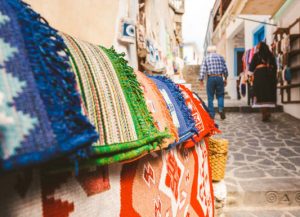
The rich vineyards in northern Karpathos produce excellent grapes, from which their famous wine is also produced. The wine of Karpathos is of excellent quality, delicious and quite different. The most popular is the semi-sweet red wine produced mainly in mountainous Karpathos, Othos and Volada. The most famous varieties of the island are the athiri, the seal, but also the Cretan thrapsathiri and the Cycladic donkey.
Karpathian cheeses have a strong flavor and are a key element of the residents’ diet. The most widespread are the very soft manouli, armyrotiri, which as its name indicates is a very salty hard cheese, with which the locals usually accompany their pasta and meriari.
Honey is a product that the housewives of Karpathos often use in their sweets, sesame honey, xerotigana and baklava. In summer honeys, thyme dominates, in spring honeys, sage and in winter ones, riki. Alochorta are small herbs that are usually eaten as a salad. They grow on cliffs among thorns.
Examples, also, of the meticulousness of Karpathos artistic concern and itscommitment to traditional professions, are the woodcarvings, temples, sofas, benches, furniture, but also the handmade footwear (stilettos, slippers) which, fortunately, are still preserved (mainly) on Olympus.
What is admirable and probably does not exist to such an extent elsewhere, is the instrument making. In all the villages, there are people of all ages who make lyres, lutes, violins, and most of them are instrumentalists themselves.
North Karpathos

With the improvement of the road network and the construction of the port in Diafani in the early 1990s, the visit of tourists to the area increased and this acted as a trigger for the construction of hotels and rooms for rent.
However, the north of Karpathos does not have a suitable infrastructure for the reception of mass tourism, something that would alter the particularly traditional character of the area and cause irreparable damage to the natural environment.
Due to the exceptional natural environment of the area with traditional settlements of special architecture, important archaeological sites, numerous churches and excellent beaches that can be visited.
North Karpathos is ideal for mild forms of tourism with cultural, historical and naturalistic interests. Undoubtedly, the most effective way to get to know the area and its beauties is by hiking.
Indeed, North Karpathos has a well-developed network of hiking routes (trails) through which one can get to know all the remarkable points of the region. Of particular interest are the old cobbled paths that are found, which retain their traditional character to this day.

Culture
Karpathos has a very large and rich folk culture and still preserves its traditions and customs with great commitment. This commitment is due to its geographical location and to the genuine and pure Greek soul of the Karpathians.
Many Greeks and foreigners dealt with Karpathos and plenty of folklore material has been published in books, magazines and newspapers, but also a great deal remains unpublished in the hands of researchers.
It is remarkable how reverently, not only the permanent residents, but also the Karpathians of the diaspora preserve the philological, but also the traditional folklore of the island.
Folk songs and spur-of-the-moment mantinadas’, proverbs, riddles, fairy tales, myths, traditions, wishes, curses and oaths are in the mouths and in the daily conversations of Carpathian young and old, men and women.
Of course, the seated Karpathian feast has a special place, which gives the opportunity to bring the folk songs of Karpathos to life, but also presents the poetic talent of the Karpathians, with the songs of the moment, which express their pain and joy, depending on the circumstance.
Such feasts, which always involve the local musical instruments (tsabuna, lyre, lute, violin), can be seen at festivals, at social events (christenings, weddings, name days) after the rich tables with traditional foods, which are set out for all the guests.
Gastronomy and local cuisine
The local cuisine is focusing around pasta, with the famous traditional “macaroons,” made from flour and water. The dough is shaped into long strands, cut into 3-centimeter sections, and pressed in the centre with the fingers to form an indentation. After drying slightly, they are boiled, then sautéed in butter, and served with caramelized onion.
Similarly prepared are the “pseudomakaroons,” which are bites of stale bread boiled until soft (two to three minutes) in salted water.
The island offers a wide variety of breads, with all kinds and flavors: Spicy onion breads, crunchy rusks with mastic, cumin, and white sesame seeds, or with nutmeg and black sesame seeds.
The spicy onion rusks are crunchy, loaded with spices and plenty of onions. They are sesame-coated rusks, thin and crunchy, sprinkled generously with black sesame seeds. They are also found in the neighbouring island of Kasos.
“Psilokouloura” were once wedding bread rings, offered in baskets with sugar-coated almonds. These are large round rings of bread, with twelve dough strips placed vertically and horizontally inside, forming small squares where they intersect. Before baking, they are sprinkled with sesame seeds.
Anterizia, are stuffed intestines, which are thoroughly cleaned, then filled with rice, pieces of meat, and plenty of spices that have been sautéed beforehand. They are sewn up and placed in a pot with boiling water to cook. Afterward, they are fried in a little oil to become crispy. They are served alongside crispy pieces of pork, boiled together with pieces of pork fat called “milnta.”

A quintessentially Christmas dish on the island is “pichti,” made from pork. It is a mixture of meat and broth derived from boiling the cleaned and singed (to remove hairs) pig’s head. It is harmoniously combined with plenty of spices (bay leaf, pepper, cumin) and, of course, lemon juice.
The famous “vizanti” is lamb or goat stuffed with herbs and rice, slowly baked in a covered clay pot, making it the traditional Easter dish of the island. At Easter, women also bake “Christokouloures,” the characteristic “poulous,” which are thin, salty “koularia” in the shape of an “eight,” with a red egg at one end. Another Easter sweet is “tortes,” made with leavened dough filled with soft sweet myzithra cheese and flavored with dill.
Another traditional recipe is goat stuffed with rice, liver, and herbs, baked in a wood-fired oven overnight, and served with yogurt made from goat’s milk.
The island’s local cuisine is rich in pies: vegetable pies, filled with spinach and leek in the winter, and with purslane and courgettes in the summer, thick-crusted onion pies baked in a tin pan in a wood-fired oven.
What to do
To fall in love with Karpathos just see some of the island’s beaches for the first time, such as Damatria or Apella. Some are easily accessible by land while others, such as the beautiful Kato Lakos, can only be reached by sea. It goes without saying that once you land you will feel like you are in paradise, thanks to the turquoise colours of the sea and the tranquillity that you breathe.
Pine-clad slopes that go down to the sea, where the blue-white waves lazily guard the island’s golden beaches. The latter are the best that Karpathos has to offer: Windy, clean, unspoiled and the most numerous, full of promise.
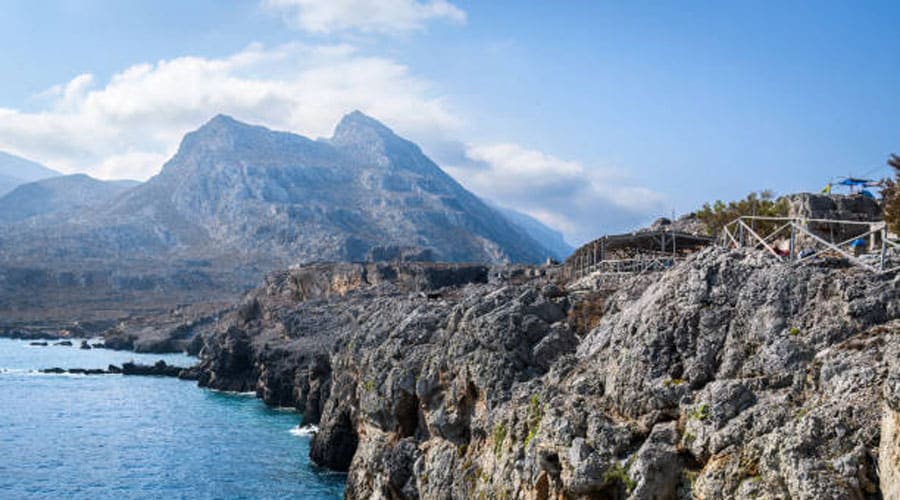
Holidays in Karpathos mean relaxation, swimming in crystal clear waters and contact with local customs and traditions. The wild windswept landscapes, the villages that look like they were taken from another era and the fine flavors of the island will be unforgettable.
Karpathos has places of rare and wild beauty, settlements of impressive architecture and vibrant tradition, a wealth of ruins from all eras of its long history.
Touring the city is a pleasant experience for every visitor. You will find beautiful images that combine island tradition with modern comforts in every neighbourhood.
Karpathos is an island with a rich history and tradition and has several museums and monuments that are worth visiting. The island is also known for its special natural beauty: high mountains and dense vegetation combine with small charming bays along the coast. Explore nature and the hidden corners of Karpathos by walking along its numerous paths!
The true soul of Karpathos is hidden in its picturesque villages and beautiful countryside, in the plateaus with the farmhouses and ancient threshing floors, in the paths that lead to holy states, in the mountain peaks that play with the clouds and the wind, in the melodies of the lyre, the lout and tsambouna, in the mandinades of the pure people of the island. And there, the uniqueness and nobility of Karpathos has no end.
Visit the villages of Karpathos
On Karpathos, you’ll find beautiful mountain villages as well as other ones by the sea. Menetes, the largest village on the island, located about 8 kilometers from the capital and is located in the southern part. It is distinguished by the Church of Panagia with its iconostasis and the panoramic view of the sea and the entire village.
Also, the village of Aperi was the island’s capital until 1892. The village is characterized by its many mansions and the beautiful courtyards of the houses.

Take the car from the capital Pigadia, on the eastern side, and drive to Mount Olympus, to experience its otherworldly beauty and its women who still wear colorful costumes today, and find yourself on the western coast looking for the Finiki, to ensure fresh fish even in the panic of the Fifteenth of August.
Every village and stop hides architectural surprises and traditional elements, for travelers with concerns. Diving enthusiasts, grab your bottles and head southeast to Kastellia with its underwater treasures, Fokia with its huge boulders and Achata with its pirate cave. Finally, Diakoftis with the Italian shipwreck (next to the airport) is also special.
Swim in one of the wonderful beaches
Karpathos boasts numerous beaches, with over 100 to choose from. Among the standout beaches is Apella, which has both sand and pebbles. It is one of the best, mainly due to its location, where greenery extends down to the sea along with the rocks.
The waters here are crystal clear. Another beautiful sandy beach is Kyra Panagia, while the beach of Agios Minas is perfect for moments of relaxation and tranquility. For more family-oriented moments, there is the organized beach of Amoopi. For kitesurfing enthusiasts, Agrilaopotamos beach, located very close to the airport, is ideal.

Explore Pigadia
The place where you’ll find everything. Firstly, it is where the island’s port is located, and it has around 3,000 permanent residents. In Pigadia (or Chora or Karpathos), you’ll find many options for restaurants and café-bars for your entertainment, as well as shops.
At the top of the hill above Pigadia, you’ll find the ruins of the ancient acropolis, and on the road to Aperi, the early Christian basilica of Agia Fotini. Pigadia is essentially a small town, so if you want to see picturesque villages, you should visit the island’s villages, which are definitely worth it..

Watch the sunset from Olympos
On Karpathos, one of the best places for watching the sunset is Olympus, with its magical colours and fantastic views. For stunning, panoramic views, visit the village of Othos. Othos often gets lost in the clouds, as it is the highest village on Karpathos at 510 meters above sea level. This gives the amphitheatrically built houses the best panoramic view.
Take a boat trip to Saria
Saria is an uninhabited island north of Karpathos. On Saria, you’ll find secluded beaches and hiking trails. There are unique pirate ruins in the Mediterranean, as Saria was once a pirate stronghold. A journey through time also awaits you at the abandoned settlement of Argos.

Go for hiking
Karpathos is a hiker’s paradise, One of the most interesting routes starts from Avlona and ends at Tristomo, at the ruins of the Casarma, the Italian barracks (3 hours and 20 minutes). You’ll find over 200 km of marked trails.
There are 50 marked trails, most of which are mapped out, and they either spread across steep slopes or pass through the island’s traditional villages. Karpathos is also a climbing destination. The island offers more than 300 routes with varying degrees of difficulty.
Do some shopping
Shopping in Karpathos is a delightful experience that allows visitors to immerse themselves in the island’s vibrant culture and discover unique treasures. The charming villages and bustling markets offer a diverse array of goods, from traditional handicrafts to contemporary fashion, ensuring there’s something for every taste.
Exploring the narrow streets of the island’s villages reveals a plethora of boutique shops and local stores. Here, you can find traditional Greek products such as handmade ceramics, embroidered textiles, and intricately crafted jewelry.
These authentic souvenirs not only make for meaningful mementos but also provide a glimpse into the island’s rich artistic heritage.
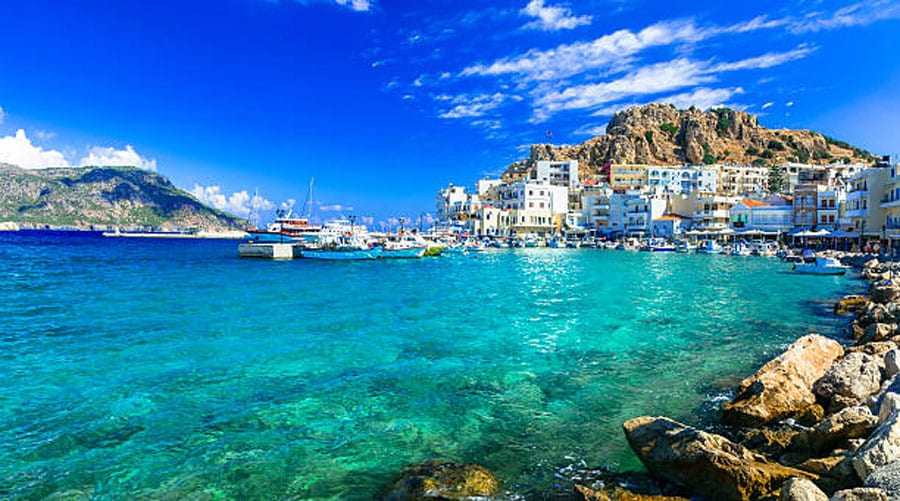
Drive around Karpathos
Take the car (essential for your travel) from the capital Pigadia, on the eastern side, and drive to Mount Olympus, to experience its otherworldly beauty and its women who still wear colorful costumes today, and find yourself on the western coast looking for Finiki, to secure fresh fish.
Every village and stop hides architectural surprises and traditional elements, for travelers with concerns.
Diving enthusiasts head southeast to Kastellia with its underwater treasures, Fokia with its huge boulders and Achata with its pirate cave. Finally, Diakoftis with the Italian shipwreck (next to the airport) is also special.
What to see
Archaeological Museum of Karpathos
Admire the special architectural building of the Province (from the time of the Italian occupation) in Pigadia, with its magnificent arches, which looms at the left end of the port. An information center for the protection of the Mediterranean seal operates here, as well as a museum with exhibits from the Prehistoric and Historical years, from early Christian basilicas and settlements on the island as well as historical data on piracy, etc.
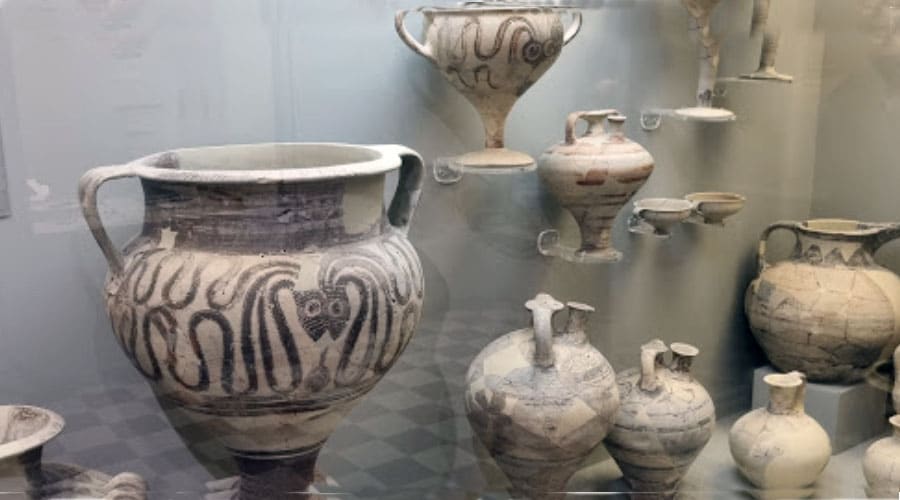
The Acropolis of Arkasa
The Acropolis of Arkasa is perched on a high plateau, offering strategic views over the Aegean Sea, which was essential for the defense against potential invasions. The advantageous positioning of this acropolis reflects a common practice in ancient Greek city-planning where acropolises were built on elevated grounds to serve as fortified sanctuaries during times of war. The intertwining narratives of Hellenistic and early Christian era seen through the remnants at this site enrich the historical evoloution of the island, making it a noteworthy destination for those interested in archaeology and the ancient history of Karpathos.
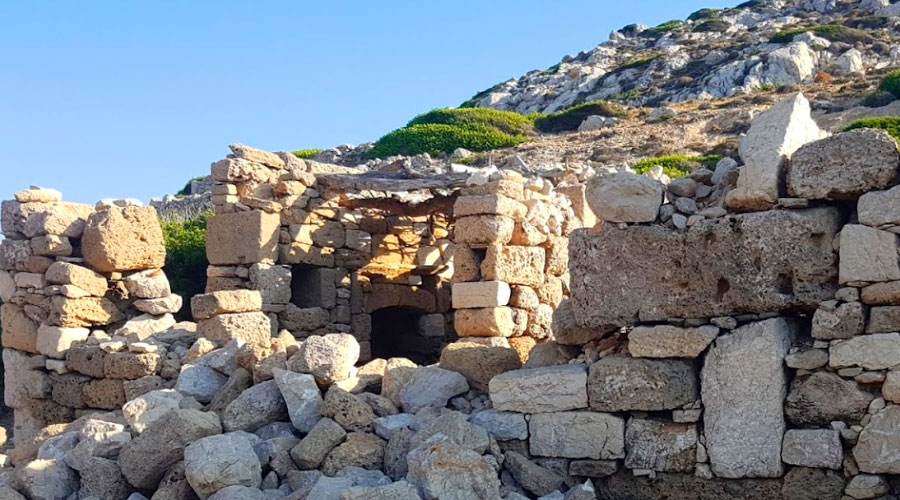
Paleokastro
In the oldest location of the island, Arkasa, the hill of Paleokastro dominates. Photograph the ruins of the ancient city and head to the foothills to see what remains of the early Christian Hagia Sophia (from the 5th century) with its exquisite mosaic floors and marble columns in its peristyle.
This ancient fortress is believed to have been constructed during the Byzantine era, although some sources suggest it could have origins dating back to the Classical or Hellenistic periods. The exact history is somewhat ambiguous due to the layers of occupations and renovations that occurred over the centuries.
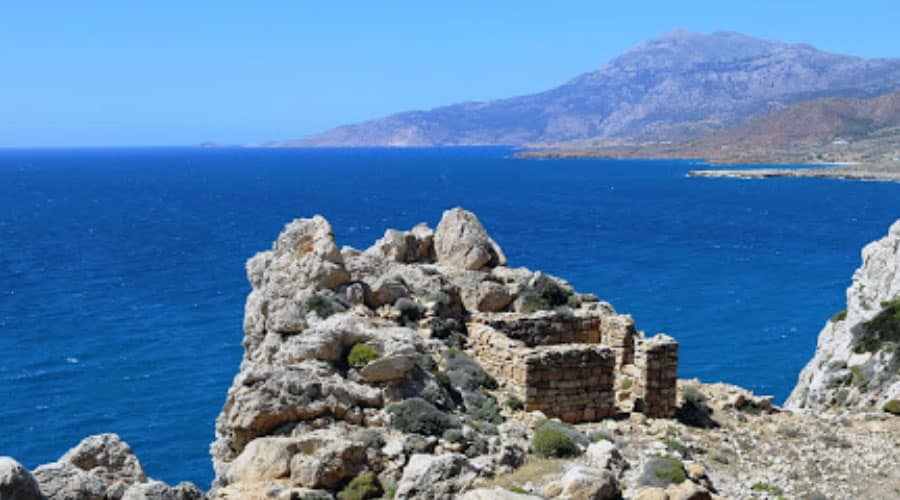
Windmills of Olympos
In addition to being a wonderful village, Olympus also has the most photographed place. The windmills, lined up in a straight line. Traditionally, the windmills on Karpathos were used for grinding grain, particularly wheat and barley, which were staple crops of the island. The windmills are an ingenious example of utilizing the natural resources available on the island; the strong and consistent winds, particularly the Meltemi winds in the summer, provided the necessary power to operate the millstones.
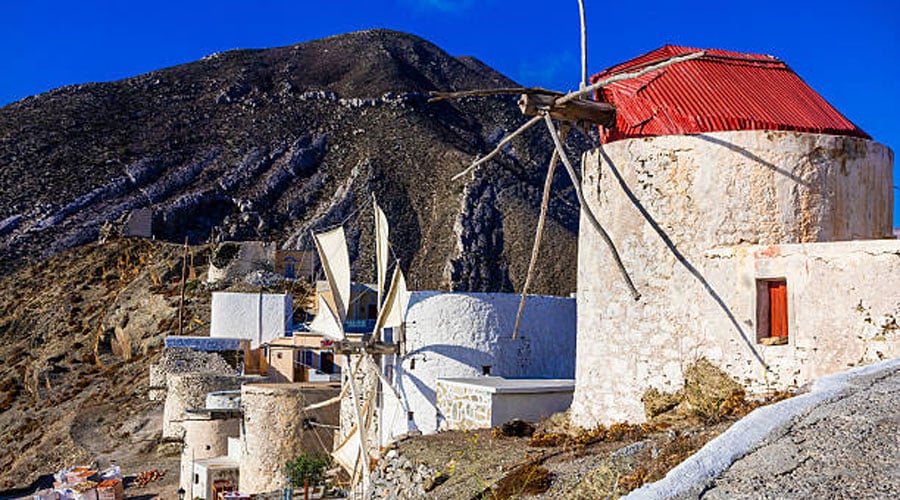
Folklore Museum of Menetes
It is a sight-seeing village, as at an altitude of 510 m, images of infinite beauty are set up, with the clouds so low that you will feel you can touch them! The museum represents a traditional house of the island with its textiles, embroideries and wood-carved couch.
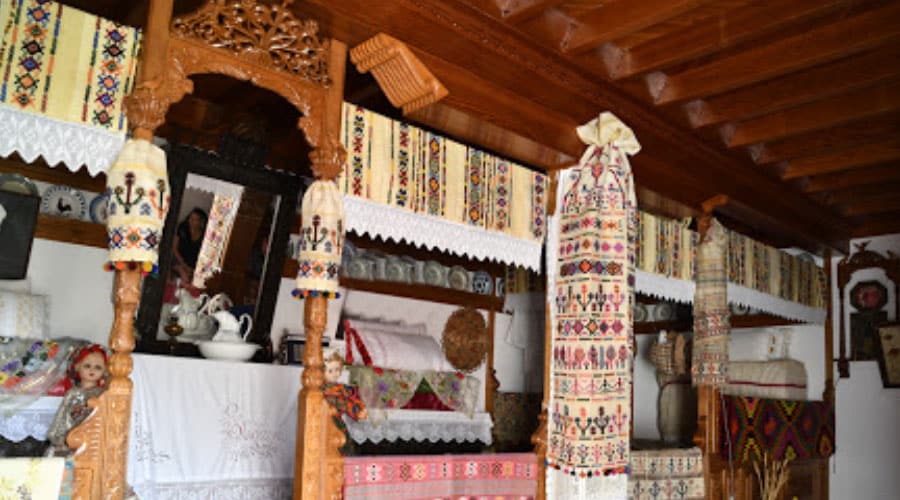
Karpathos Villages
Karpathos has ten villages and some smaller settlements, which following the road network form two “circles” on the map going around the island.
Starting the course for the short route from the capital of Karpathos and the town of Pigadia, visitors follow the road towards the east coast of the island and up to the village of Aperio which was the former capital of the island.
Follow the route that passes through the three mountain villages of Volada, Othos and Pyles until the road begins to descend towards the west coast of Karpathos. To complete the route, visitors follow the road to the village of Arkasa and continue towards Menetes high until they return back to Pigadia.
For the longest route, after reaching the village of Aperio and again instead of turning left towards the village of Volada, visitors follow the road to the northern part of the island. After an enchanting drive, visitors will reach the small village of Spoa with its many windmills.
At this point the road leads to the famous village of Olympos. After a long journey, visitors return to Spoa and after passing the small village head towards the western part of the island and the village of Mesochori. After Mesochori follow the main road to reach Arkasa, Menetes and it returns again to Pigadia.
Pigadia
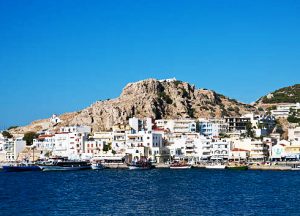
At the entrance to the port, there raises the rock bearing the remains of the citadel. All around the vestiges, there is a multitude of traditional homes – possibly the most dense collection of them in this area.
Carved in the mountain slopes there are the villages of Menetes, Othos and Volada. Underneath the village of Volada, there lies the picrturesque settlement of Aperi. There are 1700 people dwelling in Pigadia.
Amoopi
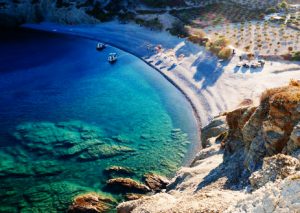
The coastal settlement of Ammoopi in recent years has shown great tourist development.
It is located midway from the island’s airport to the city, which makes it ideal as a place to stay.
In addition, it has one of the most beautiful beaches, well organized, which is suitable for water sports.
Aperi
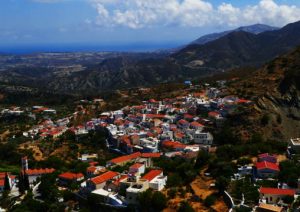
Invisible from the sea, it was a safe haven from corsair raids.
Up until the island fell under the Ottonam rule, this settlement bore the name of Karpathos.
The name “Aperi” derives from the Turkish word “Aperghi”, meaning “the capital town”. With a population of 400, this settlement lies within an 8 km distance from the town of Karpathos.
Arkassa
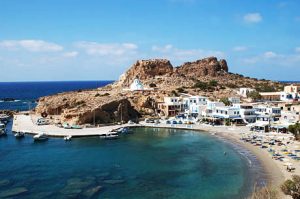
There are 400 people dwelling in Arkassa, lying within 16 km from Pigadia.
Near the settlement there is an archaeological site that includes the acropolis of Palaiokastro which has remains of fortifications from the Archaic times and towers from the classical and Hellenistic eras.
Also, various early Christian churches are preserved in the area, the main one being that of Agia Anastasia, while on the eastern side of Arkasa there are the Middle Byzantine churches of Panagia Marmarini and Agios Georgios.
Diafani
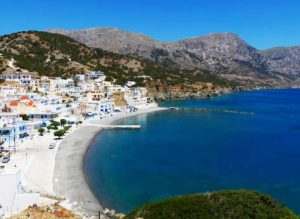
This is the second port of Karpathos. A pebbly beach is offered to the pleasure of swimmers and sun worshipers.
There are 250 people living in Diafani, reachable through Mesochorio after a 67 km drive South West from the town of Karpathos.
Lefkos
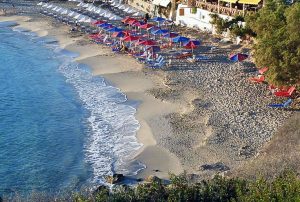
There is a beautiful pine grove around the settlement. Population: 25 – Lefkos is located in the center of the island at a distance of 33 km from Pigadia.
It is the port of the Mesochori area and its main holiday resort . Northwest of the village and the northern side of the bay of the same name is the islet of Sokastro which in ancient times was a peninsula that was cut off after an earthquake and on which there are remains of a Byzantine fortification and a settlement with vaulted buildings
Makris Gialos
A favourite tourist destination, extending between Afiartes and the airport, with spacious sandy beaches, crystal-clear azure waters set against the austerity of an arid valley in the background, where surfing aficionados from all over the world converge to practice their favourite sport. Location: 15 km to the south of the town of Karpathos.
Volada
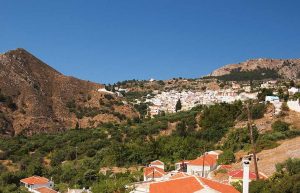
Volada adds a white accent to a lush green slope. The houses in Volada, with their whitewashed exteriors, winding streets, and flower-filled courtyards, appear as though guarded by the remnants of three castles, constructed in different eras.
Menetes
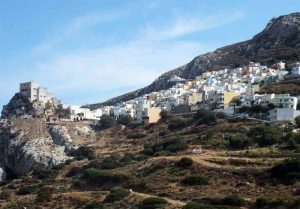
Its 450 inhabitants take special pride in the church of the Dormition, dominating the settlement from its extremity.
There is a thoroughfare typically cutting the village in two. Picturesque, beautiful little homes with flowerpots to contrast against the whitewashed walls harbour a long tradition of culture, as most celebrated musicians of the island were born here.
It is no secret that the people of this village have been delving into a long tradition of poetry and music.
Mesochori
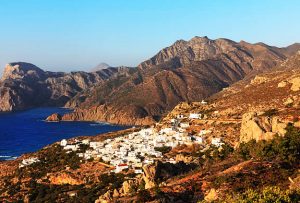
Mesochori basks in the sunset and contemplates on the inmensity of the sea beyond. Above the fountains, there rises the Church of Panaghia Vruyssiani.
Only a few houses remain to remind the old architectural tradition. Lore is nevertheless very much alive in the hears and manifestations of its 350 inhabitants. Distance: 24 km NW from the town of Karpathos.
Othos
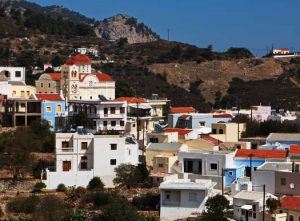
With some 8 to 10 feasts hosted here every year, it is small wonder that the village of Othos has come to be a synonym of merriment and celebration.
The main road running through the settlement continues on to the village of Pylaes.
There are 230 people living in Othos, which lies at 12 km north west from the town of Pigadia.
Olympos
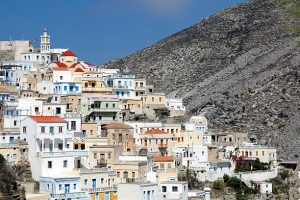
This is a journey through several traditional villages, plains, pine-grown hills and steep, barren rocky mountains offering some truly breathtaking views on the sea.
It is then that the township of Olympos appears, in a way entirely of its own, a splash of white against a most austere background. Its 300 people zealously preserve their tradition and usages in everyday life.
Spoa
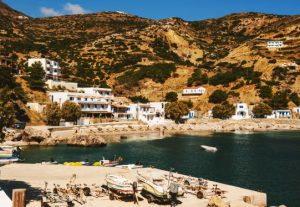
The area occupies the east and central of the island of Karpathos and borders to the North with the village of Olympos, to the South with the Mesochori and to the North with the village od Volada.
From a geographical point of view Stoa also extend within the area of the Mesochori, a fact that can be interpreted based on the common historical origins of these two villages. The Eastern coast of Spoa is washed by the Sea of Karpathos.
Karpathos beaches
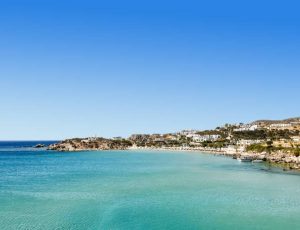 Worldly or more low profile, with sand or pebbles, with strong winds for water sports, the beaches of Karpathos offer options for every style. Towards the North is the sandy Afoti with the backdrop of the columns and stone carvings of the early Christian basilica of Agia Fotini from the 6th century, while the most popular beach is Kyra-Panagia with the organized sandy beach at the edge of the rocky bay.
Worldly or more low profile, with sand or pebbles, with strong winds for water sports, the beaches of Karpathos offer options for every style. Towards the North is the sandy Afoti with the backdrop of the columns and stone carvings of the early Christian basilica of Agia Fotini from the 6th century, while the most popular beach is Kyra-Panagia with the organized sandy beach at the edge of the rocky bay.
For the alternatives, the beaches of Agios Nikolaos and Agios Georgios in the settlement of Arkasa are recommended. The pebbly Achata (10 km northwest of Pigadia) that deepens sharply and Apella with its 7 km long golden sandy beach also stand out. Diafani, at a distance of 70 km from Pigadia, is also – although distant – a recommended destination (you can also get here by ferry from Pigadia). Finally, Ammoopi (just 6 km from Pigadia) with its organized beach and tamarisk trees is suitable for lovers of water sports.
The beauty of Karpathos however remains the beaches and the sea: those of the east coast are more sheltered and tend to be gravel (such as Amoopi, Apella or Kato Lako, reachable only on foot), while those of the southern part of the island are sandy, like Damatra or Diakoftis.
The beaches of the west coast, on the other hand, are exposed to the winds that blow steadily on the island, so they are the favorite destination for kitesurfing or windsurfing lovers, while the usual bathers can only enjoy them on days of low wind. Many beaches on the island are considered to be among the most beautiful in Greece.
Beautiful and also very different from each other: you will find white beaches in pristine scenery, quiet and peaceful rocky coves, equipped beaches for those who love relaxation and comfort. Going around the island to visit them is not a choice, but a real necessity!
Getting around Karpathos
Getting around Karpathos is a seamless experience, thanks to the variety of transportation options available. Whether you’re exploring the traditional villages, heading to the beaches, or venturing into the rugged landscapes, Karpathos offers convenient ways to get around that cater to different preferences and travel styles.
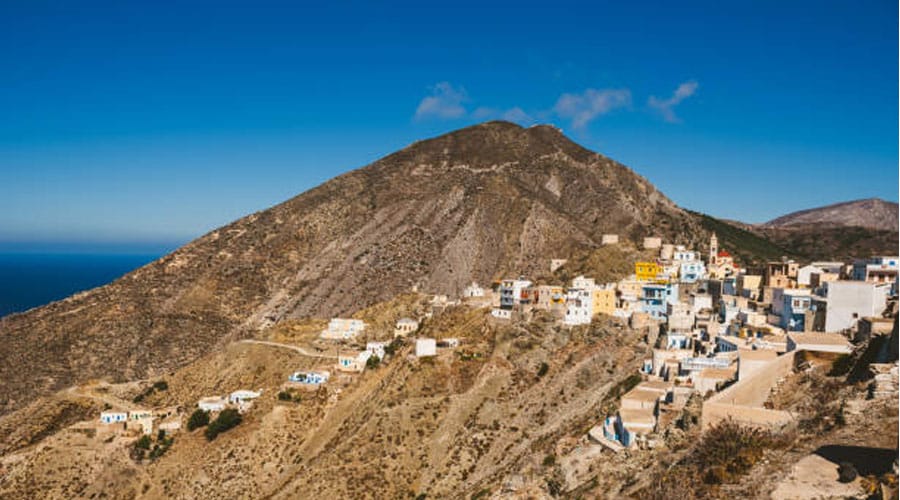
Taxis are an efficient mode of transportation on the island. Found in key areas such as the airport, main squares, and popular tourist spots, taxis provide a comfortable and hassle-free way to reach your destination. While they may not be as prevalent in some of the more remote villages, they are a convenient choice for short trips or transfers between major locations.
Buses in Karpathos are a cost-effective and popular means of transportation, especially for those looking to explore the island’s various attractions on a budget. The bus network connects the main villages, beaches, and tourist destinations, offering both residents and visitors a reliable way to move around the island. The schedules are designed to accommodate the needs of both locals and tourists, making it relatively easy to plan your excursions.
Car hire is a popular option for those seeking greater flexibility and the freedom to explore Karpathos at their own pace. Rental agencies can be found at the airport, in major towns, and near popular tourist areas. Having a car allows you to venture off the beaten path, discover hidden gems, and access remote locations that might not be easily reached by public transportation. The island’s well-maintained road network ensures a pleasant driving experience.
Exploring Karpathos on foot is a delightful option, especially in the island’s charming villages. Wandering through narrow alleys, discovering local shops, and immersing yourself in the traditional architecture can be a rewarding way to experience the culture and atmosphere of Karpathos.
Weather in Karpathos
The climate of the island of Karpathos is similar to the other southern Greek islands,. It is quite similar to Rhodes or Crete: it primarily means a hot Mediterranean summer without significant precipitation and a mild but often rainy winter. The weather characteristic of Karpathos is special in that the summers are even drier than average and there is often even less rainfall than elsewhere. This is somewhat offset by the higher humidity due to the proximity of the sea, so that the vegetation living in certain parts of Karpathos and most of the forests here are lush green even in the middle of summer.
The wind is almost constantly present in the Karpathos area, the strength of the winds can vary from a very light breeze to an almost stormy force occurring on top of the mountains. In the summer, the Meltemi wind, which occurs in the Aegean Sea region, is of great importance, and it primarily cools the hot summer days. For this reason, Karpathos is referred to by many as the windiest Greek island, as the Meltemi can really be very strong at certain points of the island.
When to Go
If you are planning a holiday to Karpathos and have complete freedom of choice, you should know that the best times to fully enjoy all the island has to offer are from mid-June to early July and in September. During these periods, the Meltemi wind is generally less intense and less frequent. This makes the climate ideal for enjoying the beaches and engaging in outdoor activities such as trekking, windsurfing, or simply relaxing on the beach.
Another advantage of visiting Karpathos during these times is the reduced crowding. After the peak of the summer tourist season, the island becomes less busy, allowing for a more enjoyable experience of its natural beauty and facilities. Tourist services, such as hotels and restaurants, also tend to offer more personalised attention to visitors.
Moreover, travelling outside the peak season can also mean lower costs for flights and accommodation, making Karpathos a more economical choice without compromising the travel experience. With fewer tourists and lower prices, you can explore the island at a more leisurely pace and delve deeper into the local culture and traditions without the hustle and bustle of summer crowds.
If your holiday period falls in July and August, don’t worry: Karpathos is still perfectly enjoyable during these summer months. Although July and August are the high season, with a greater influx of tourists and warmer, windier weather conditions, there are numerous reasons why this island remains an excellent summer destination.
How to get to Karpathos
Karpathos is one of the most remote Greek islands . There are various options to consider when planning your journey to the island, as it has a port with frequent ferry connections to Piraeus, the port of Athens, as well as to other Greek islands. Additionally, there is a new airport that connects Karpathos to major European airports.
By Air
Flying to Karpathos is very simple and often cheap, thanks also to some direct routes opened by low cost airlines.
The alternative is to fly to Athens, which can be reached in various ways from various european airports, and continue with a domestic flight. Note that this is the only way to get to Karpathos by plane outside the tourist season.
By Ferrry
The most exciting way to reach Karpathos in the summer is by ferry. The island is located halfway between Rhodes and Crete, it can be reached quite easily from Heraklion, Crete and from the port of Rhodes in a few hours by ferry.
